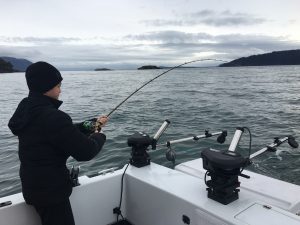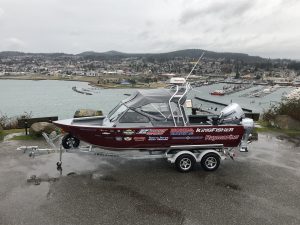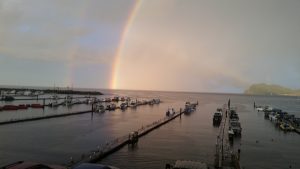Focus this month is marine salmon fishing action as more areas reopen soon Leave a reply
The clock on the wall says it’s time to hitch up the boat for some chinook fishing opportunities in the months ahead.
The San Juan Islands (Marine Catch Area 7) continue to produce some stellar hatchery chinook fishing although rough seas and bad weather has been an issue of late.
Hatchery chinook in the San Juan Islands averaged 22.55 inches with a maximum size of 27.56. In pounds most were 6 to 8 pounds with some as large as 18-plus pounds.
Go to points are Thatcher Pass; Peavine Pass; Point Doughty; Spring Pass; Clark and Barnes Islands; Parker Reef; Point Thompson; Peavine Pass; Obstruction Pass; Waldron Island; Lopez Pass; and Presidents Channel.
In the past month, more than 800 anglers have converged to San Juan Islands for the Resurrection Salmon Derby on Jan. 5-7, and Roche Harbor Salmon Classic on Jan. 18-20 – both are part of the NMTA’s NW Salmon Derby Series.
The Resurrection Derby saw 102 boats and 334 anglers with 50 hatchery chinook, and the Roche Harbor Salmon Classic generated 100 boats and 357 anglers with a whopping 179 hatchery chinook.
Next up is Friday Harbor Salmon Classic this Friday and Saturday (Feb. 9-10), and Olympic Peninsula Salmon Derby on March 9-11. For more details, go to http://www.nwsalmonderbyseries.com/.
Closer to Seattle, central Puget Sound (Area 10) is open, but hatchery chinook catches have been not nearly as good with a few glory moments coming off Jefferson Head, West Point south of Shilshole Bay, Rich Passage, Manchester, Southworth and Allen Bank off the south side of Blake Island.
The daily catch limit in Area 10 was raised from one to two hatchery chinook daily. Average marked chinook in Area 10 was 18.23 inches with a maximum size of 26.63.
In south-central Puget Sound around Tacoma (Area 11) – open through April 30 – the action has taken a turn in the wrong direction for the moment with spotty action reported.
Hood Canal (Area 12) is open until April 30, and southern Puget Sound (Area 13) is open year-round for salmon. This gives anglers the unique opportunity to pursue salmon 24/7 in Washington’s marine waterways.
As always be sure to check the regulation pamphlet for any last minute changes at https://wdfw.wa.gov/.
Those looking for angling plans in mid-February and March to pursue hatchery chinook will definitely need to put the Strait of Juan de Fuca (Areas 5 and 6), and northern Puget Sound and east side of Whidbey Island (Areas 9, 8-1 and 8-2) on their radar.
Last month the Washington Department of Fish and Wildlife (WDFW) staff and sport-fishing advisory board decided to postpone northern Puget Sound and east side of Whidbey Island until Feb. 16 (original opening date was Jan. 16), and should extend the fishery on the back end of the season.
All three areas of Puget Sound closed sooner than expected back in November after sub-legal chinook – fish under the 22-inch minimum size limit – appeared in numerous numbers.
Test fishing last month still showed a spike of sub-legals. In Area 9 the average marked fish size was 20.07 inches and maximum size was 24.43; Area 8-1, 14.30 and 25.39; and Area 8-2, 17.04 and 22.13.
Delaying the openers should provide a more quality fishery in late-winter and early-spring when larger fish begin to appear.
Unless guidelines are achieved sooner than expected Area 9 will stay open through April 15, and 8-1 and 8-2 will be open through April 30.
For salmon fishing junkie like myself, a “must do” chinook fishery lies in the western Strait of Juan de Fuca off Sekiu (Area 5), which is open from March 16 to April 30; and eastern Strait off Port Angeles (Area 6) open from March 1 to April 15.
The Straits offers plenty of prime choices for winter chinook from Ediz Hook, Winter Hole and the humps off Port Angeles – as well as the exposed banks – to Freshwater Bay and Pillar Point Point to Caves off Sekiu.




